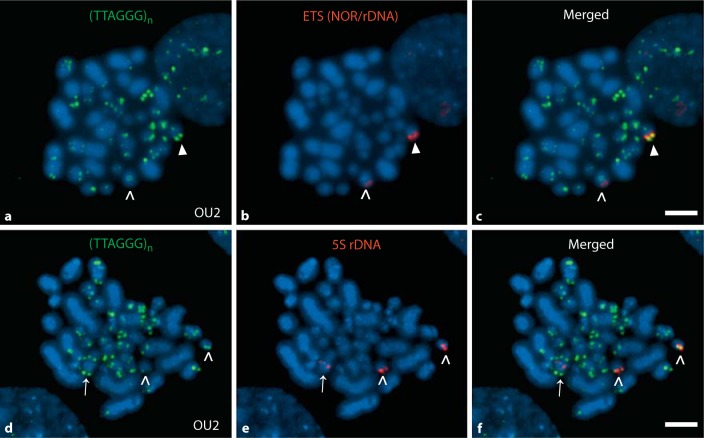Fig. 1.
Cytogenetic profile of the immortalized OU2 cell line: heterogeneous telomeres and karyotype alterations. The immortalized CEF cell line OU2 exhibits a heterogeneous telomeric profile with telomeres of variable length between homologous and among nonhomologous chromosomes. Mapping of the rDNA-encoding chromosomes by FISH provides evidence for derivative chromosomes and aneuploidy. Telomeric profile of OU2 using a telomeric PNA probe for detecting telomeric array sequences (TTAGGG)n (a), an ETS (red) probe (ETS identifies the 18S-5.8S-28S rDNA, also known as the nucleolus organizer region, NOR) detected 2 chromosomes (>, ▸) both larger than the normal GGA16 (b) with the colors merged in image c. Although the ETS-detected chromosomes are similar in size, 1 homolog exhibited both a brighter/more intense ETS signal and a brighter/more intense telomere signal localized to the same end (b, c, ▸), than the other homolog (b, c, >). Telomeric profile of OU2 chromosomes at a less-condensed stage (d) which provides a generally enhanced signal profile compared to the signal in a. The 5S rDNA probe (red) hybridized to 3 chromosomes indicating a trisomic condition e. Two of the chromosomes were of a size expected for GGA9 (>) whereas the locus indicated by the third 5S rDNA signal was observed in the middle of a larger chromosome (→) suggesting an additional chromosome rearrangement. The telomere on one of the GGA9 chromosomes was typically brighter than the other one as seen in the merged-probes image (f, right >). Both GGA9 and 16 display mega-telomeres in other genotypes [Delany et al., 2007; O'Hare and Delany, 2009]. In general, OU2 contains a reduced number of microchromosomes for the diploid chicken genome, indicates more intermediate-sized chromosomes and as shown by FISH results possesses derivative chromosomes and aneuploidy. Scale bar = 5 μm.

